What’s on your fridge?
No, this is not an essay about eating habits — I would never subject you to that.
My constant quest to find the archive and nostalgia in everything, coinciding with the holidays, has me thinking a lot about where we store our physical memorabilia, and the hierarchy behind it. In my last essay, I did a deep dive on scrapbooking and junk journaling, and the art of collecting that so many of us partake in. I’m always intrigued to see what’s deemed important enough to save. You can be someone who thinks Everything Is Important, and I used to be like this once, and legend has it that I still am. But I’ve always lived in small apartments, and space was never on my side, so if the memorabilia fit in a shoebox that could be stored under my bed, then it made the cut. This always felt like a good compromise; it was easy to access and put a moratorium on my growing obsession.
When thinking about alternative ways of collecting and curating ephemera, I find one of the most overlooked one is the outside of fridge. Think back to when you were a kid: Were there photos on there? Greeting cards, or maybe random notes? When I close my eyes, I remember it changing with the seasons; holiday cards, acceptance letters, take-out menus, and the list goes on. The fridge clutter (and I use that word lovingly) becomes a place of both compilation and curation. Unlike a junk journal which incorporates everything, including literal refuse, the fridge door looks a lot more like a gallery wall of someone’s life. Last year, writer (and queer icon) Peyton Dix wrote for Clever about what your fridge decor says about you as a person. She writes:
Adorning your refrigerator is an active choice, one that lets people know who you are, who you care for, and where you’ve been. It is both personal and performative. A letter is a daily reminder. A photo can be a core memory. A fridge can hold the landmarks of your life, showing you the condensed version of your world made up by deliberate or even subconscious selections of memories that are meant to be seen and shared. The kitchen might be the heart of the home, but the fridge is the soul.
Dix brings up a great point: although the fridge exterior is filled with our personal memorabilia, unlike a box that gets stored away, it’s on display for whomever enters our abode. It can be in many ways, as she refers to it, a performance… Look at this picture of us on vacation! We’re well traveled and cultured, dammit! But it’s can also be a moment to show off your achievements as a family. Put up that report card with good grades or that acceptance letter – you deserve to be reminded of your wins.
The history of fridge decor itself is fragmented, in the sense that it doesn’t quite exist. When refrigerators entered domestic households around 1927, they were big, bulky, expensive, and most importantly not magnetic. Simply put, the technology wouldn’t allow it. However, this design became fatal: because of a single latch on the outside of the fridge, if you locked yourself inside, you would be trapped. This unfortunately put many children’s lives in danger and by 1951, California had passed a law stating that you couldn’t discard a fridge where a child could access it, and later amended it stating that fridge doors had to be removed before disposing. By 1956, the United States passed the Refrigerator Safety Act, stating that a fridge had to be easily opened from the inside, which led to adding a magnetic feature on the doors. This meant it could be easily opened and closed on either side. This life saving technology led to the creation of the fridges we are familiar with today. Fridge magnets, which increased popularity in the 70’s, became a huge novelty, as they were easy to make and were often sold at an affordable price. It’s the best of both worlds — an item that’s both decorative and functional.
Truth be told, I love a good magnet. It’s a tiny souvenir living on your fridge, holding up baby pictures and wedding invitations for years to come. Having one gifted is even better: a tiny ceramic sculpted landscape of a town from a foreign country that somehow fits onto a 3 inch magnet…it’s truly magnificent work. During one of my many moves in NYC, I’d left my magnets on the fridge, but luckily left the apartment to a friend, so just imagine my reaction when I finally return five years later and see my baby picture from Sears plastered on the side. I’m happy knowing that other people cherish my things just as much as theirs, recognizing the sanctity of a 30 year old relic.
Dix says later in her text, “My fridge is where memory meets utility,” which I think is one of the biggest excitements surrounding this decor. It’s a functional archive, mixing and matching memories with reminders, both the past and future colliding, like an ever changing altar. When doing a little digging for this essay, I was disappointed to find that not many people were writing about their fondness for their fridge doors. Most of the articles focused on curating the insides of their fridges (dubbed “fridgescaping”), carefully organizing fruits, veggies, cheeses, snacks, drinks, all separated and unboxed into different containers. Instead of getting enraged by yet another trend encouraging overconsumption, I turned to ol’ faithful (Pinterest) and lo’ and behold, people are sharing pictures of the fronts of their fridges, filled with fun things!
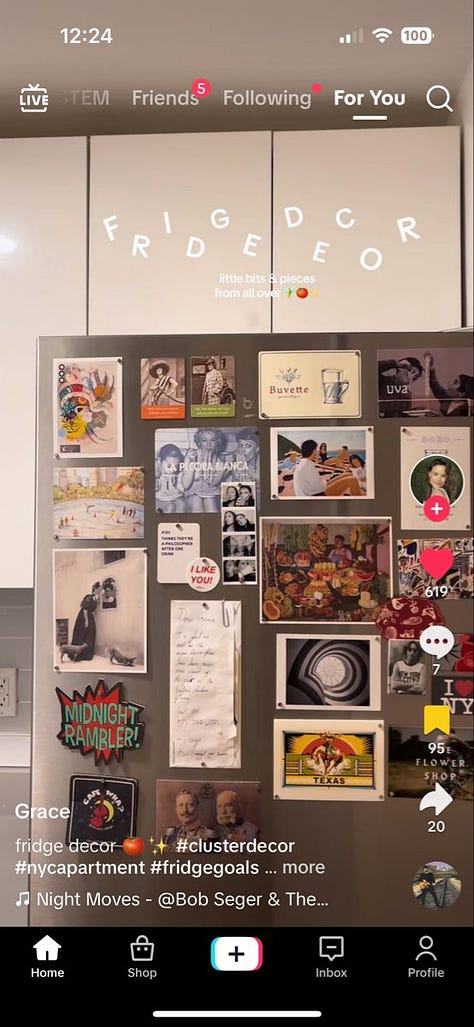
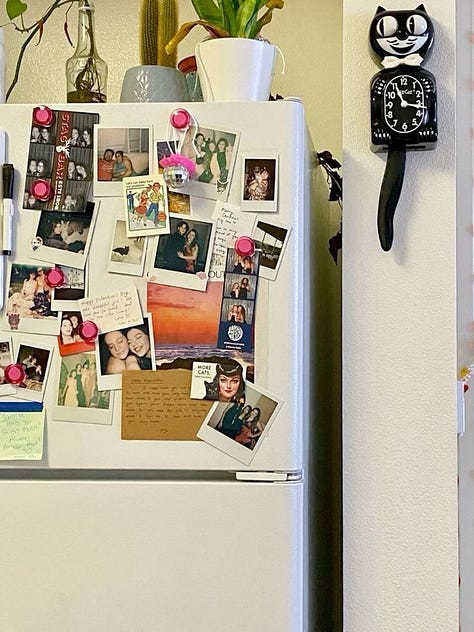
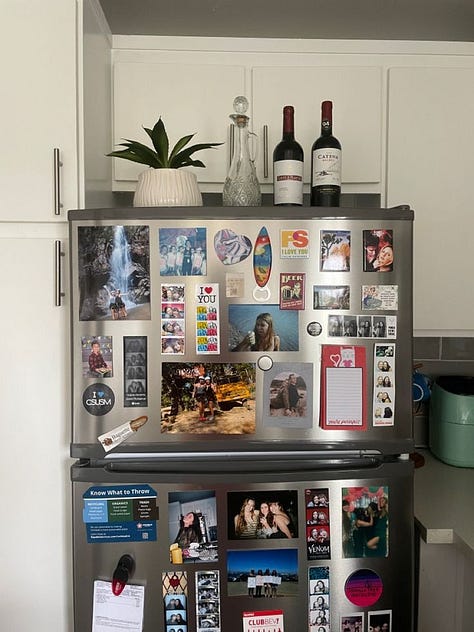
Another part of what excites me about the aesthetic decor is that maximalism is encouraged. (By the way, over-consumption and maximalism are not the same, but that’s an essay for another time…) It’s a living collage, pieces constantly moving and changing across the fridge. Some people approach it like designing a layout, leaving equal distance between each object, others just stacking papers on top of each other and praying to the magnetic gods that everything stays up. My fridge is pretty simple, a work in progress, if you will. I keep a magnet with measurement conversions because I’m tired of looking for my phone while cooking and frantically looking up “how many tbs in cup” - yes, I write like a caveman because why waste time when say lot word when few word do trick? There’s also magnets with recipes for sofrito and sazon, and many pictures of Max and I throughout the years.
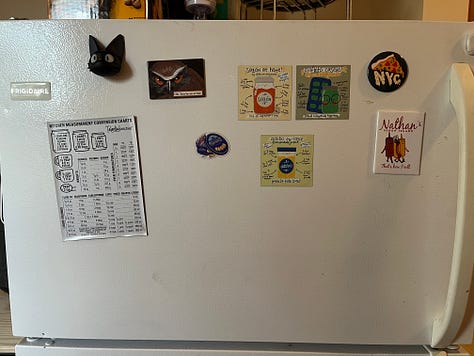
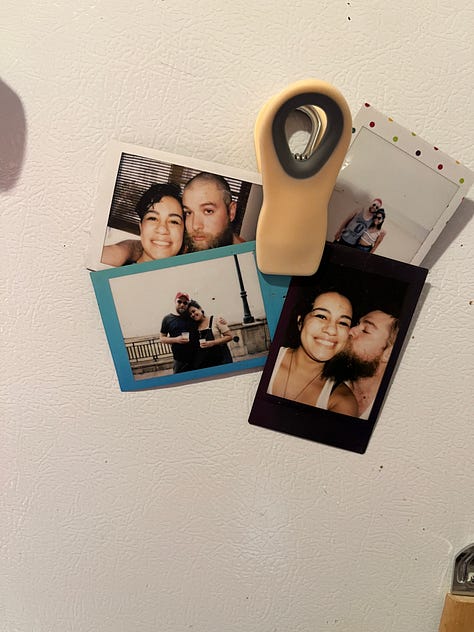
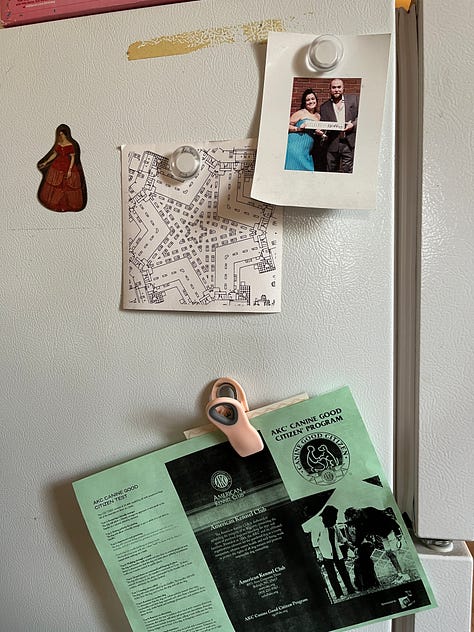
After looking at dozens of pictures of people’s fridges, I’ll admit I have a bit of FOMO (Fear of Missing Out). Having only been in situated back in Brooklyn for a year and a half, we haven’t accumulated enough things to my liking - but we’ll get there. It’s a process that simply can’t be rushed. Assembling all of these items is key, and having them out on display is the best part. It’s for everyone, but also not just anyone. For the lucky people that get invited to your home, those you trust and care about, that you’d break bread or share wine with, the ones that get invited to the kitchen to see the chaos — they’re the ones that get the privilege to see your most treasured pieces of paper.

So, in moment of insanity, I reached out to people on social media, asking for them to send me pictures of their fridges. And the people delivered! I’ve gotten so many pictures, and dozens of promises to send pictures when they’re back home from their holiday travels. I’ve learned anything from this, it’s that people really adore a classic fruit magnet. I guess there’s something about bananas that simply speak to people across all walks of life.

Side note, I encourage you to send me pictures of your fridges. Feel free to send them over Instagram, or reply to this email. Happy Holidays and see you next time!
A





I absolutely loved this! When my wife and I were first dating ~10 years ago, we had a cork board where we pinned everything - notes to each other, concert tickets, hospital bracelets from random ER visits. I took an archival photo of the board every few months, and it's so fun to look back at them.
i have front AND side to fill!